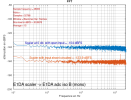Hi all, not sure if anybody is still following this thread but I wanted to show you my Cosmos ADC + Scaler measurements as there is something wrong and I'm not sure if there is anything I can do or there is an issue with my Scaler unit. So I just received the Scaler this week and I was keen on testing it. I made my cables and I did some measurements on some DACs I have at home. I was surprised to see that the Scaler adds substantial noise. I then performd some ADC+Scaler noise measurements to see what is going on. The results are shown below:
View attachment 398362
As you can see, the Cosmos ADC has great noise figures. It's a "Grade A" device and I'm really happy with how it performs so far. But when I add the Scaler, things do not look so good. Even at the no gain setting the noise measured in REW is -108 dBFS A, considerably higher than the standalone ADC. I had a look here :
http://archimago.blogspot.com/2022/11/early-look-e1da-cosmos-scaler-prototype.html and the results he reports (-121.6 dBFS A) at max gain (26dB) are much better that I have. The setup seems very similar to what I have. My setup is shown below:
View attachment 398368
The ADC and Scaler are connected together with two jack to XLR cables I made. I then connected the input of the Scaler to the output of the D50s (not powered) so that it does not pick-up any noise form the environment. Both the ADC and the Scaler are powered from battery packs (one for each device).
Is there something I'm missing or doing wrong or is there an issue with the Scaler unit I got?
Any input is highly appreciated. Thanks!
